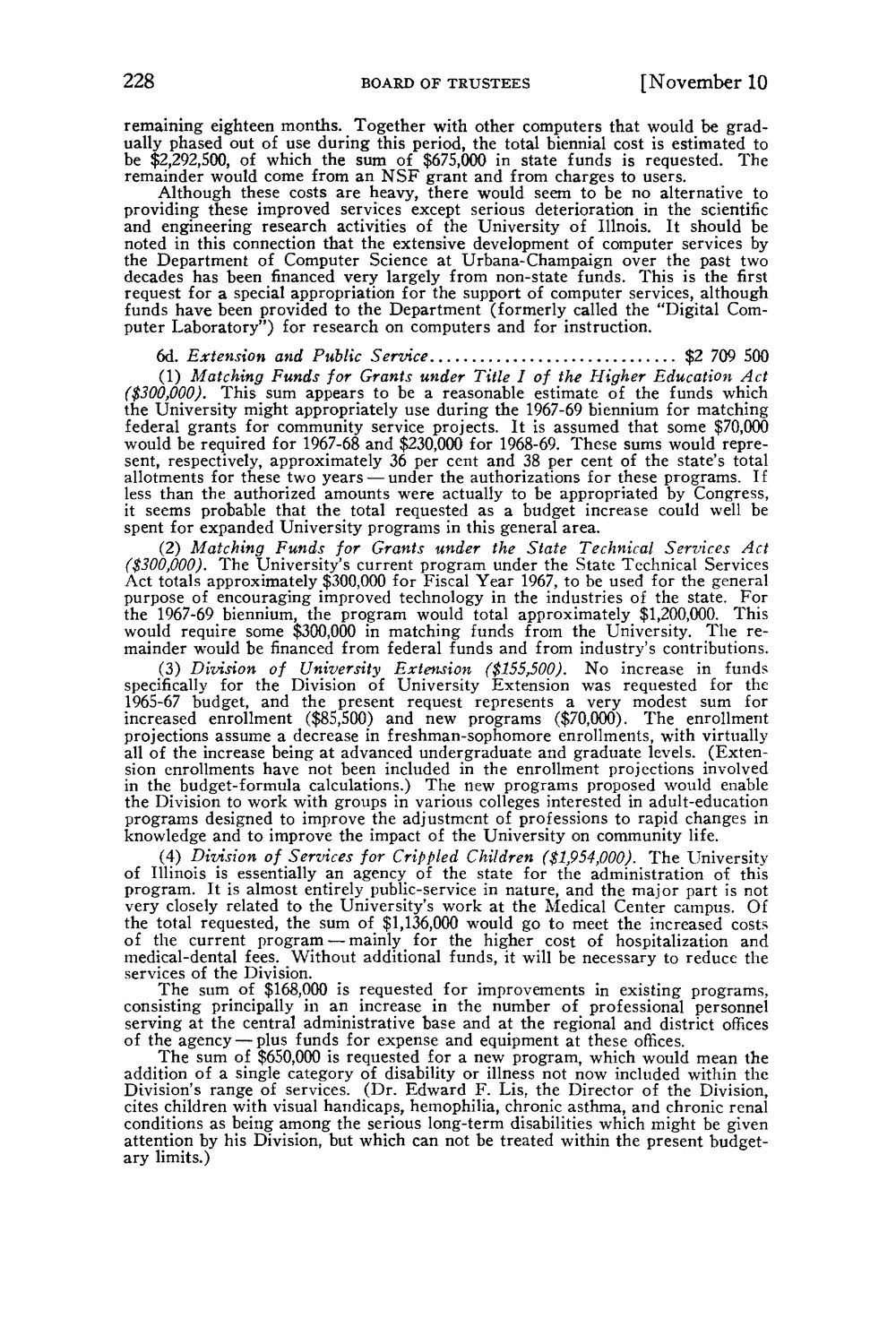| |
| |
Caption: Board of Trustees Minutes - 1968
This is a reduced-resolution page image for fast online browsing.

EXTRACTED TEXT FROM PAGE:
228 BOARD OF TRUSTEES [ N o v e m b e r 10 remaining eighteen months. Together with other computers that would be gradually phased out of use during this period, the total biennial cost is estimated to be $2,292,500, of which the sum of $675,000 in state funds is requested. The remainder would come from an N S F grant and from charges to users. Although these costs are heavy, there would seem to be no alternative to providing these improved services except serious deterioration in the scientific and engineering research activities of the University of Illnois. It should be noted in this connection that the extensive development of computer services by the Department of Computer Science at Urbana-Champaign over the past two decades has been financed very largely from non-state funds. This is the first request for a special appropriation for the support of computer services, although funds have been provided to the Department (formerly called the "Digital Computer Laboratory") for research on computers and for instruction. 6d. Extension and Public Service $2 709 500 (1) Matching Funds for Grants under Title I of the Higher Education Act ($300,000). This sum appears to be a reasonable estimate of the funds which the University might appropriately use during the 1967-69 biennium for matching federal grants for community service projects. It is assumed that some $70,000 would be required for 1967-68 and $230,000 for 1968-69. These sums would represent, respectively, approximately 36 per cent and 38 per cent of the state's total allotments for these two years — under the authorizations for these programs. If less than the authorized amounts were actually to be appropriated by Congress, it seems probable that the total requested as a budget increase could well be spent for expanded University programs in this general area. (2) Matching Funds for Grants under the State Technical Services Act ($300,000). The University's current program under the State Technical Services Act totals approximately $300,000 for Fiscal Year 1967, to be used for the general purpose of encouraging improved technology in the industries of the state. For the 1967-69 biennium, the program would total approximately $1,200,000. This would require some $300,000 in matching funds from the University. The remainder would be financed from federal funds and from industry's contributions. (3) Division of University Extension ($155,500). No increase in funds specifically for the Division of University Extension was requested for the 1965-67 budget, and the present request represents a very modest sum for increased enrollment ($85,500) and new programs ($70,000). The enrollment projections assume a decrease in freshman-sophomore enrollments, with virtually all of the increase being at advanced undergraduate and graduate levels. (Extension enrollments have not been included in the enrollment projections involved in the budget-formula calculations.) The new programs proposed would enable the Division to work with groups in various colleges interested in adult-education programs designed to improve the adjustment of professions to rapid changes in knowledge and to improve the impact of the University on community life. (4) Division of Services for Crippled Children ($1,954,000). The University of Illinois is essentially an agency of the state for the administration of this program. It is almost entirely public-service in nature, and the major part is not very closely related to the University's work at the Medical Center campus. Of the total requested, the sum of $1,136,000 would go to meet the increased costs of the current program — mainly_ for the higher cost of hospitalization and medical-dental fees. Without additional funds, it will be necessary to reduce the services of the Division. The sum of $168,000 is requested for improvements in existing programs, consisting principally in an increase in the number of professional personnel serving at the central administrative base and at the regional and district offices of the agency — plus funds for expense and equipment at these offices. The sum of $650,000 is requested for a new program, which would mean the addition of a single category of disability or illness not now included within the Division's range of services. (Dr. Edward F. Lis, the Director of the Division, cites children with visual handicaps, hemophilia, chronic asthma, and chronic renal conditions as being among the serious long-term disabilities which might be given attention by his Division, but which can not be treated within the present budgetary limits.)
| |